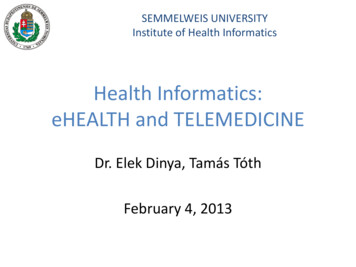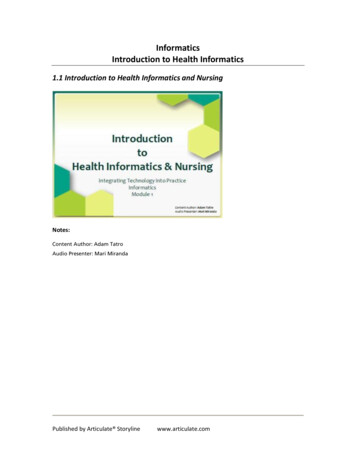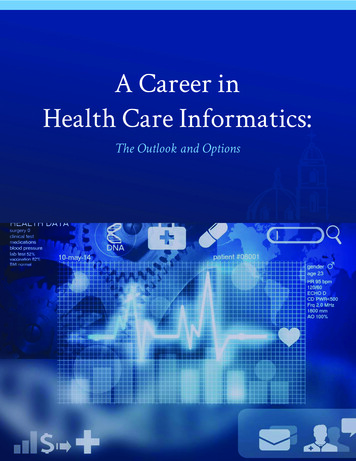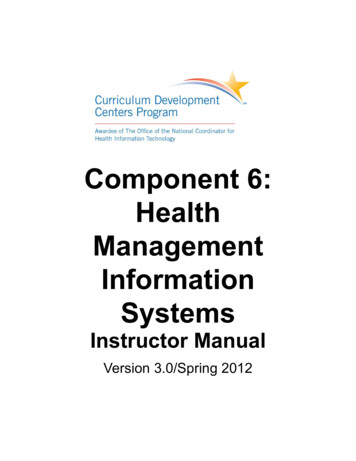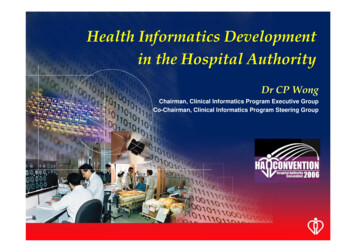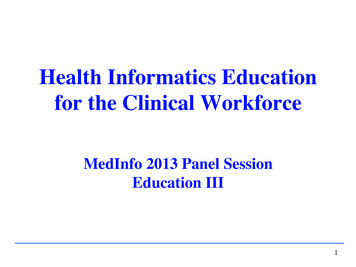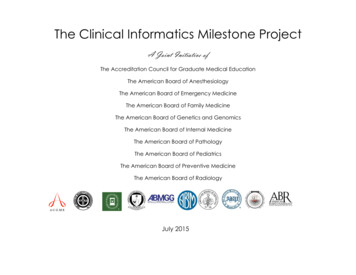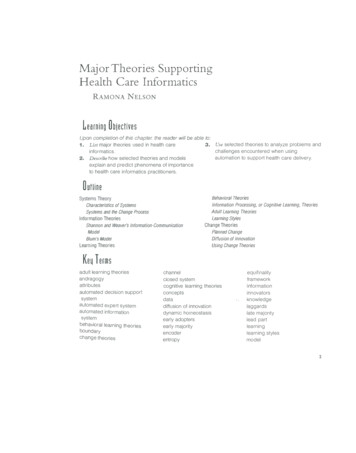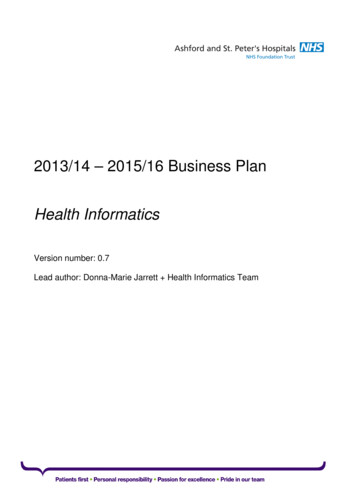
Transcription
The correct bibliographic citation for this manual is as follows: Woodside, Joseph M. 2018. Applied Health Analytics andInformatics Using SAS . Cary, NC: SAS Institute Inc.Applied Health Analytics and Informatics Using SAS Copyright 2018, SAS Institute Inc., Cary, NC, USA978-1-62960-881-5 (Hardcopy)978-1-63526-616-0 (Web PDF)978-1-63526-614-6 (epub)978-1-63526-615-3 (mobi)All Rights Reserved. Produced in the United States of America.For a hard copy book: No part of this publication may be reproduced, stored in a retrieval system, or transmitted, in anyform or by any means, electronic, mechanical, photocopying, or otherwise, without the prior written permission of thepublisher, SAS Institute Inc.For a web download or e-book: Your use of this publication shall be governed by the terms established by the vendor atthe time you acquire this publication.The scanning, uploading, and distribution of this book via the Internet or any other means without the permission of thepublisher is illegal and punishable by law. Please purchase only authorized electronic editions and do not participate in orencourage electronic piracy of copyrighted materials. Your support of others’ rights is appreciated.U.S. Government License Rights; Restricted Rights: The Software and its documentation is commercial computersoftware developed at private expense and is provided with RESTRICTED RIGHTS to the United States Government. Use,duplication, or disclosure of the Software by the United States Government is subject to the license terms of this Agreementpursuant to, as applicable, FAR 12.212, DFAR 227.7202-1(a), DFAR 227.7202-3(a), and DFAR 227.7202-4, and, to theextent required under U.S. federal law, the minimum restricted rights as set out in FAR 52.227-19 (DEC 2007). If FAR52.227-19 is applicable, this provision serves as notice under clause (c) thereof and no other notice is required to be affixedto the Software or documentation. The Government’s rights in Software and documentation shall be only those set forth inthis Agreement.SAS Institute Inc., SAS Campus Drive, Cary, NC 27513-2414November 2018SAS and all other SAS Institute Inc. product or service names are registered trademarks or trademarks of SAS Institute Inc.in the USA and other countries. indicates USA registration.Other brand and product names are trademarks of their respective companies.SAS software may be provided with certain third-party software, including but not limited to open-source software, which islicensed under its applicable third-party software license agreement. For license information about third-party softwaredistributed with SAS software, refer to http://support.sas.com/thirdpartylicenses.
ContentsAbout this Book . viiAcknowledgments . ixChapter 1: Introduction .1Introduction .1Audience Accessibility .2Learning Approach .3Experiential Learning Activity: Learning Journal.8Chapter 2: Health Anamatics .9Chapter Summary .9Chapter Learning Goals .9Health Anamatics .9Health Informatics .14Experiential Learning Activity: Telemedicine .19Health Analytics .20Health Anamatics Architecture .26Experiential Learning Activity: Evidence-Based Practice and Research .28Health Anamatics Careers .29Experiential Learning Activity: Health Anamatics Careers.30Learning Journal Reflection.32Chapter 3: Sampling Health Data . 33Chapter Summary .33Chapter Learning Goals .33Health Anamatics Process .34Health Anamatics Tools .34SEMMA: Sample Process Step .36SAS OnDemand for Academics Setup .38Experiential Learning Application: Health and Nutrition Sampling .39Experiential Learning Application: Health and Nutrition Data Partitioning .55Experiential Learning Application: Claim Errors Rare-Event Oversampling .62Learning Journal Reflection.64Chapter 4: Discovering Health Data Quality . 65Chapter Summary .65Chapter Learning Goals .65Healthcare Quality .66Experiential Learning Activity: Healthcare Data Quality Check .70
ivHealthcare Data Quality Case Study . 70Six Sigma Health Data Quality . 71Experiential Learning Activity: Public Data Exploration . 72SEMMA: Exploration . 73Experiential Learning Activity: Health Data Surveillance . 75SEMMA: Modify . 76Experiential Learning Application: Heart Attack Payment Data . 77Experiential Learning Application: Data Quality Exploration . 97Learning Journal Reflection . 98Chapter 5: Modeling Patient Data . 101Chapter Summary . 101Chapter Learning Goals . 102Patients . 102Patient Anamatics . 102Patient Data. 102Healthcare Technology Disruption . 104Experiential Learning Activity: Personal Health Records . 106SEMMA: Model Process Step . 107Experiential Learning Application: Caloric Intake Simple Linear Regression. 110Experiential Learning Application: Caloric Intake Multiple Linear Regression . 113Model Summary . 115Experiential Learning Application: mHealth Heart Rate App . 116Experiential Learning Application: Inpatient Utilization - HCUP . 118Reflection . 120Chapter 6: Modeling Provider Data . 123Chapter Summary . 123Chapter Learning Goals . 124Providers . 124Provider Anamatics . 125Provider Data . 126EHR Implementations . 127EHR Implementation and Success Factors . 128EHR Implementation Process . 131Experiential Learning Activity: Electronic Health Records . 133SEMMA: Model . 134Experiential Learning Application: Hospital-Acquired Conditions . 137Model Summary . 155Experiential Learning Application: Immunizations . 155Learning Journal Reflection . 158
vChapter 7: Modeling Payer Data . 159Chapter Summary .159Chapter Learning Goals .159Payers .160Payer Anamatics .161Payer Data .162Claim Forms .163Experiential Learning Activity - Claim Forms Billing .164Experiential Learning Activity: Claims Adjudication Processing .165Electronic Data Interchange .167Experiential Learning Activity: EDI Translation.173SEMMA: Model .174Experiential Learning Application: Patient Mortality Indicators .177Model Summary .197Experiential Learning Application: Self-Reported General Health .197Learning Journal Reflection.199Chapter 8: Modeling Government Data . 201Chapter Summary .201Chapter Learning Goals .202Government Agencies .202Government Health Anamatics .203Government Regulations.204Experiential Learning Activity: Government Data Sharing .207Government Billing and Payments .209Experiential Learning Activity: Billing Issues and Fraud and Abuse .210SEMMA: Model .211Experiential Learning Application: Fraud Detection .215Model Summary .235Experiential Learning Application: Hospital Readmissions .235Learning Journal Reflection.238Chapter 9: Health Administration and Assessment . 241Chapter Summary .241Chapter Learning Goals .242Health Anamatics Administration.242Code Sets .244Security .246Privacy .247Experiential Learning Activity: HIPAA Administration .249SEMMA: Assess.251Experiential Learning Application: Health Risk Score.252Assess Summary .270
viExperiential Learning Application: Hip Fracture Risk . 270Learning Journal Reflection . 273Chapter 10: Modeling Unstructured Health Data . 275Chapter Summary . 275Chapter Learning Goals . 275Unstructured Health Anamatics . 276Social Media . 276Experiential Learning Activity: Social Media Policy . 278Social Media Maturity . 279Experiential Learning Activity: Dr. Google . 280Text Mining . 281Experiential Learning Application: U.S. Presidential Speeches . 285Model Summary . 305Experiential Learning Application: Healthcare Legislation Tweets . 306Learning Journal Reflection . 308Chapter 11: Identifying Future Health Trends and High-Performance Data Mining . 309Chapter Summary . 309Chapter Learning Goals . 310Population and Consumer Changes . 310Artificial Intelligence and Robotics Automation . 313Experiential Learning Activity: Robotic Surgery . 314Healthcare Globalization and Government . 316Public Health . 318Big Data Health Anamatics. 319Big Data and High-Performance Data Mining Model . 321Experiential Learning Application: SIDS . 323Model Summary . 333Healthcare Digital Transformation . 334Experiential Learning Application: Lifelogs . 336Learning Journal Reflection . 339Experiential Learning Application: Health Anamatics Project . 340References . 343Index . 363
About This BookWhat Does This Book Cover?Health Anamatics is formed from the intersection of data analytics and health informatics. There issignificant demand to take advantage of increasing amounts of data by using analytics for insights anddecision-making in healthcare. This comprehensive textbook includes data analytics and health informaticsconcepts along with applied experiential learning exercises and case studies using SAS Enterprise Miner inthe healthcare industry setting. The intersection of distinct areas enables connections between dataanalytics, clinical informatics, and technical software to maximize learning outcomes.Is This Book for You?This textbook is intended for professionals, lifelong learners, senior-level undergraduates, and graduatelevel students, it can be used for professional development courses, health informatics courses, healthanalytics courses, and specialized industry track courses.What Are the Prerequisites for This Book?An introductory statistics course and an introductory computer applications course are the recommendedprerequisites for this book. Topics in an introductory statistics course might include descriptive statistics(frequency, central tendency, and variation) and inferential statistics (sampling, probability, correlation, andexperimental design). Topics included in an introductory computer applications course might includecomputer hardware, productivity software (Microsoft Office, Excel, Word), data access and manipulation,and strategic use of technology.What Should You Know about the Examples?Experiential learning activities and applications are included in each chapter so that you can gain hands-onexperience with SAS in various healthcare disciplines and in real-world settings. The practical nature of thisbook helps you to integrate healthcare, analytics, and informatics into health anamatics knowledge, skills, andabilities.Software Used to Develop the Book's ContentSAS Enterprise Miner 14 is the graphical user interface (GUI) software for data mining and analytics.Example Code and DataYou can access the example code and data for this book by linking to its author page athttps://support.sas.com/woodside.
viii About this BookAbout the AuthorDr. Joseph M. Woodside is an Assistant Professor of Business Intelligence andAnalytics at Stetson University teaching undergraduate, graduate, and executivecourses on analytics, health informatics, business analysis, and information systems. Hehas been a SAS user for over ten years and is responsible for updating the analyticslearning goals and course content for the SAS Joint Certificate Program. Beforeaccepting the Business Intelligence and Analytics position at Stetson, Dr. Woodsideworked with KePRO, a national healthcare management company, as the VicePresident of Health Intelligence, with responsibility for healthcare applications,informatics, business intelligence, data analytics, customer relationship management,employee wellness online platforms, cloud-based systems deployment strategy,technology roadmaps, database management systems, multiple contract sites, and program management.Dr. Woodside previously held positions with Kaiser Permanente, with responsibility for HIPAA ElectronicData Interchange (EDI), national claims and electronic health record implementations, National ProviderIdentifiers, cost containment financial analytics, and various data analytic initiatives. Learn more about thisauthor by visiting his author page at http://support.sas.com/woodside. There you can download free bookexcerpts, access example code and data, read the latest reviews, get updates, and more.We Want to Hear from YouSAS Press books are written by SAS Users for SAS Users. We welcome your participation in theirdevelopment and your feedback about SAS Press books that you are using. Please visit sas.com/books to dothe following: Sign up to review a book.Recommend a topic.Request information on how to become a SAS Press author.Provide feedback on a book.Do you have questions about a SAS Press book that you are reading? Contact the author throughsaspress@sas.com or https://support.sas.com/author feedback.SAS has many resources to help you find answers and expand your knowledge. If you need additional help,see our list of resources: http://sas.com/books.
Chapter 1: IntroductionIntroduction .1Audience Accessibility .2Learning Approach .3Experiential Learning Activity: Learning Journal .
Health Anamatics is formed from the intersection of data analytics and health informatics. Healthcare systems generate nearly 1/3 of the world’s data, and healthcare stakeholders are promised a better world through data analytics and health informatics
